Interview with Michael Murphy on Spring Fishing with the Flit
ima has recently introduced it’s new Flit jerkbait, and anglers everywhere are eager to be the first to try the new Flit this spring!
In this issue, Michael Murphy (“MM“), designer of the Flit is interviewed, with a question and answer session focused on fishing the Flit during the spring time.
This interview certainly won’t cover every facet of fishing the Flit. We’ve aimed at what you may need to know to get started with the Flit in March and continue using it in April and May. As you read, think spring time and what bass are doing now. Later in the season, we will share additional tips on using the Flit – summer Flit tactics, fall and winter Flit tactics we will provide in future issues. For now, we hope you enjoy the interesting Flit facets below for spring fishing with the Flit. Thank you.
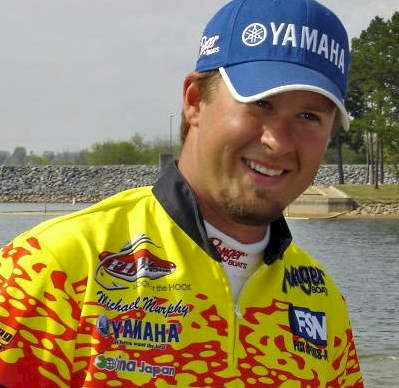
ima Flit designer Michael Murphy
Q?: To set the scene, what kind or rod, make or model do you fish with the Flit? What reel? What line?
MM: The rod I like to use is the Fenwick Elite Tech, ECPS69MH-F. This is actually a 6’9″ Pitching stick. I stand 6’5″ tall, and with the elevation of the boat bow above the water, standing on the front deck, this rod is the perfect rod for me to be able to point my rod tip straight down without dragging in the water. I believe this is critical for ease of use, to hold the rod straight down without hitting the water, but this will be different for everyone. For a shorter person, it may be a 6′ rod. Overall, I like a medium/heavy action rod with some good backbone but still a good amount of tip for casting, working the lure and for playing a fish gingerly if it is barely hooked.
Q?: How do you recommend to attach your line to the Flit? Why?
MM: Directly to the eyelet. Some like to use a clip on their jerkbaits, hoping to get more action. This action is already naturally build into the Flit without having to do this. Adding a clip would most likely result in the front hook continuously catching the line. A clip is not needed. Simply tie direct to the split ring already provided on the lure. As far as knots, any type of good cinch knot goes well with fluorocarbon, except I do not like to use a Palomar with fluorocarbon since I believe it increases the chances of knot failure, and I do like to use fluorocarbon on my Flit.
Q?: How deep does the Flit dive? Are there any certain types of cover or structure or something else specific that’s an ideal situation for the Flit due to its working depth?
MM: Many jerkbaits are first designed on looks (eye appeal) and then the bill is constructed to achieve action and depth. Since the Flit is designed based on the idea of matching the hatch and to mimic the cadence of baitfish, specifically of the herring family (i.e., blueback herring, gizzard shad and threadfin), the action is already built into the Flit body. The bill is there to only achieve depth, not impart action. If you would like it to achieve its maximum depth, point your rod tip down toward the water to obtain 8 feet of depth on 8 lb fluorocarbon or 6 feet of depth on 10 lb fluorocarbon. You may change the position of your rod tip to make it run shallower. With your rod tip pointing directly up at an eleven o’clock position, you can make it walk just beneath the surface. The Flit very effective, whether used to fish deep on bluff walls or shallow just under docks.
Q?: Is there anything you can do in terms of rod, line or retrieve or any other bait adjustment that lets you reach different depths? Is there anything that can make the difference of getting the Flit a couple of feet deeper or shallower?
MM: As mentioned above. line diameter and also line type do make a difference. The general idea whether using the ima Flit jerkbait or the ima Shaker crankbait, is the smaller the line diameter the deeper the bait will go, simply due to less line drag. However, with the Flit, the exception to this would be at rest. Mono floats and fluoro sinks. You could use this to your advantage to behave differently or run at different depths dependent on specific situations. Again, this will vary among line brands and types. No two lines are exactly the same.
Q?: Sometimes a bait gets categorized as a smallmouth killer or a spotted bass killer, or a largemouth magnet. Do you think the Flit has a special or higher appeal to smallmouth, spotted bass or largemouth? Why or why not?
MM: I couldn’t tell you. The Flit catches all three bass species equally and all very effectively. I think you can’t tag this type of reputation on the Flit, since all three species feed on members of the herring family, which makes them all equally vulnerable. I can tell you, with all three bass species there are no differences. They all eat it most excellently. If anything I would call it the “anything that swims and feeds on baitfish magnet” because it is not just with bass, but it could be redfish, pike, perch, gar, you name it. I have caught practically everything on the Flit so far.
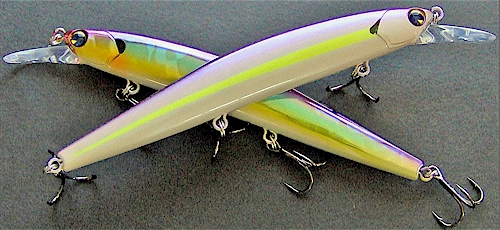
Q?: Some anglers mention having a good jerkbait bite first thing in the morning, and then have it fade out and die on them by mid-morning. Is that something you’ve seen about the Flit bite? Is the Flit bite similar to what some have experienced with an early morning topwater bite, that it’s usually good at first light, and shuts down once the sun hits the water? Or is there anything you can do or any conditions or factors that make for a good Flit bite all day (or as long as those factors remain present)?
MM: No. It is not like that. As the sun comes up, I start to chase shadow lines. It may be the shadow line off of a bridge, dock, trees, bluffs, etc. Seems like bass will just pull tight to these shaded areas. It is not just with jerkbaits, I would say this applies with all lures under these early morning conditions and it is merely the natural behavior of how bass act. I say this, because I would never say a topwater bite will completely shut down. Instead, it will just change. I have had some of my best topwater days on Lake Lanier over 30 feet of water on clear bluebird days catching both spotted bass and largemouth. I think the shutting down of any bite or that sudden “lock jaw” is nothing more than a myth. Strike zones and the willingness to commit may become smaller, or how fish may hold to structure may change under changing conditions. However, at the end of the day. it is all basic behavior and simply what makes the best sense for how a bass can ambush its prey. Bass are always eating, it is just a matter of how or where. I have never seen a tournament where someone did not catch something. So I am not a big believer in a bite shutting down because the fish were not eating. The bite just changes or shifts. As anglers, we may lose the bite, but it’s still going on somewhere.
Q?: What would you say is the biggest error you see anglers make with jerkbaits?
MM: Certainly it’s stereotyping the technique. The belief that it is only good for spring and for post frontal situations. They (jerkbaits) are good all the time.
Q?: Overall, what action are you trying to create with a jerkbait, and with the Flit specifically? What impression are you trying to make on the bass with the Flit? Is it supposed to be an injured or disoriented baitfish – or a perfectly normal baitfish movement?
MM: Both. You can make it look disoriented or like a normal baitfish. Whatever condition or mood the bass may be in, you can match it. The Flit can be fished with random jerk and pause techniques, or with a consistent walking side to side motion. It is based on the concept like a Zoom Fluke or other soft jerkbait, or a topwater like a Super Spook. Both the Fluke and Spook have very effective actions. Now imagine being able to do that on a bigger scale, better and where you are more easily able to catch the fish that are just slapping at it and not really willing to commit. You’ll hook a good percentage of these non-committal fish with a jerkbait.
Q?: With the jerk component of the action you create, do you vary the jerk for different seasons or different reasons?
MM: Yes, the colder or less active the fish are, the tighter the walk or the shorter the jerks I will use with a longer pause. The warmer or more active the fish are, the harder I will lay into the jerks and the more frequent and consistent I will work the lure with less pauses.
Q?: With the pause component of the action you create, do you vary the pause for different seasons or different reasons?
MM: Yes, as mentioned above.
Q?: Which is the most important part, the jerk or the pause?
MM: It depends on the time of the year. Both are equally important. This goes back to the previous two questions.
Q?: What other elements are there to the action? Is the reeling an important element? How fast or how far you reel, do you vary that? Any other elements to the action except the jerk, the pause, the reeling?
MM: I typically reel a quarter to a half a turn per jerk. With this type of technique, the reel is nothing more than a tool to hold the line, and a good drag and high speed retrieve when fighting a fish.
The most important elements to working a jerkbait are the rod action and how you work the rod. In addition, your attention to details of what happens to the jerkbait on different jerks and rod angles, and tying all this together to discover what is most persuasive action to the bass on any given day.
Q?: Do you look to develop a cadence or Flit “action” for the day? That is, once you catch a few on a certain sequence of jerks and pauses, do you find all your fish going for that same sequence of jerking-pausing? Or do you catch fish on a diversity of cadences during the same day?
MM: Absolutely a cadence or “rod action pattern” materializes many days. This goes right along with my previous answer and the paying attention to details that spell what is the fish’s preference for the day or for the situation at hand.
Q?: At what point do most strikes occur? What induces the strike – the jerk, the pause, the reeling in or what?
MM: The pause, over 90% of the time.
Q?: How would you say that jerking, pausing and reeling in a jerkbait differs from popping, pausing and reeling in a topwater popper? Is it essentially the same action for a popper and a jerkbait? If not, what are the differences between working a topwater popper and working a jerkbait (except of course you can see the popper)?
MM: Yes, they’re both pretty much the same. Especially in the aspect that there are about as many different and effective ways to work a popper as there are to work a jerkbait
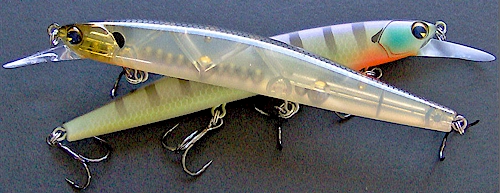
Q?: What if you suddenly see a bass following the Flit as it gets near the boat (or shore)? What do you do to convert those followers into biters? How do you get them to commit and whack it? Or if they break off the chase and drift away, how do you get them to come back and strike on the next cast?
MM: There is a technique that I discovered with the Flit, and it is the only jerkbait I have found you can do it with, because it has such tight walking action. With the right among of slack before the jerk and immediately after allowing the bait to glide, you can make the Flit literally do a 180 degree about-face. If the fish is trailing close enough and not willing to commit, you can make it bite out of mere reaction with this 180 degree turn-around maneuver. Bass don’t have hands to swat, they use their mouth, and this results in a catch. This does take practice, but it is one of the absolute coolest thing you will ever experience. I did it on Lake Murray with a 5 lb 8 oz bass, it was unbelievable!! I have done it with many other fish, but the 5 lb 8 ouncer was the coolest because it followed the Flit the first cast and peeled off, and then I was able to get it to track it again and I did this 180 on it. It was so funny because it was apparent it hit out of sheer reaction to the 180 turn-around. This bass didn’t even know what to expect or what happened. It just bit, but it didn’t even fight. That was the down side. It was pretty lethargic. At the same time, it was pretty funny.
Q?: How come so many jerkbait bass are partially hooked on the outside of the mouth? Some have suggested that the bass is slapping the lure’s tail or pushing against the lure’s tail so it can turn the long jerkbait 180 and swallow it head-first. What do you think of that?
MM: I used to have fish (two spotted bass, a largemouth, and two crappie) in an aquarium. I would feed them gold fish. If they were hungry and/or competitive, they would eat the gold fish any way they could get them down, sideways, tail first, head first, it didn’t matter. As the competition abated and/or they were getting full, they were more selective and would go for the goldfish head first. However, doing this, is a little harder for them to do. So they would ambush them from the side, battering them, with scales falling off, until the prey moved slow enough and were an easy enough target for them to successfully eat head first. With jerkbaits, I believe that may be what they are doing at times, hitting the jerkbait first as to kill or stun it to make it easier to eat. In many cases they will go through this motion with their mouth closed or mostly closed as to not eat it, just incapacitate it first. With a jerkbait, the hooks may naturally end up on the outside of the mouth.
Another explanation is far simpler. A fish swims up to inspect the bait and simply noses it, much like it would nose a jig, worm, or crayfish on the bottom of the lake out of curiosity, but with a jerkbait, because of the sticky-sharp trebles and the jerking motion of how the lure is worked, the nosy fish may get stuck around its mouth or side of the fish’s head, resulting in a catch. Such fish certainly are not intentionally being snagged, but depending on the particular state regulations or tournament rules, this may or may not be deemed a keepable catch.
Q?: Before we conclude our interview, Michael, are there any other points you’d like to mention about jerkbaits or spring time fishing with the Flit?
MM: I think we pretty much nailed many of the most important questions. I can’t think of anything else to add. Thank you for asking.


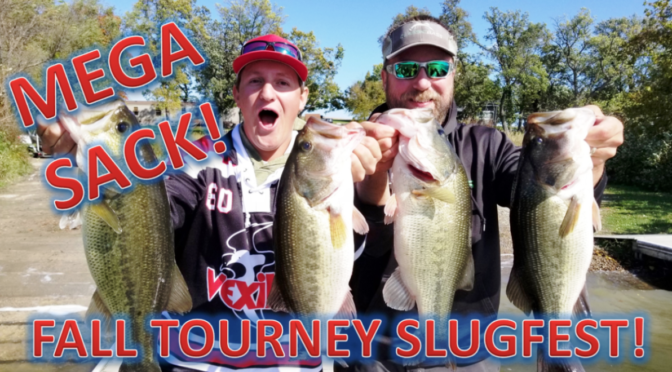
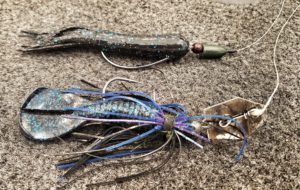





 rod on the deck of my Triton is dedicated to the Recoil Rig at all times.”
rod on the deck of my Triton is dedicated to the Recoil Rig at all times.”









